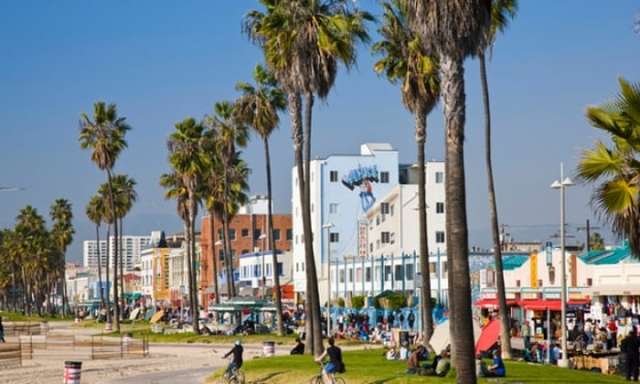Apparently not for much longer. LA’s palm trees are dying. And most won’t be replaced.
A beetle known as the South American palm weevil and a fungus called Fusarium are killing palm trees across southern California. Others are dying of old age. “It’ll change the overall aesthetic because palm trees are so distinctive. It’s the look and feel of Los Angeles,” said Carol Bornstein, director of the nature gardens at the Natural History Museum of Los Angeles.
A city tally in 1990 estimated the number of palms on city streets at 75,000, a number which has not been updated but is destined to plunge in coming decades, the Los Angeles Times reported this week, citing officials.
No one knows how many will die, or how fast. For palm lovers, the even worse news is that they won’t be replaced, perhaps not even mourned.
Authorities will instead plant other species that give more shade and consume less water – important factors for an overheating city. By the middle of the century, LA is expected to be three to five degrees fahrenheit warmer and to have triple the number of extreme heat days.
“Palms are decorative and iconic, but Los Angeles is facing more and more heatwaves, so it’s important that we plant trees that provide adequate shade to protect people and cool the city down,” said Elizabeth Skrzat, programme director for City Plants, the city’s tree planting arm.
History may record this as the moment La La Land put utility ahead of adornment.
The city will continue to plant trees in certain designated areas, including Hollywood, and developers and homeowners will probably continue to plant palms. “I seriously doubt that palms will disappear entirely,” said Skrzat.
Even so, the looming die-off dismayed Becky Saava, 40, a tourist from Uganda who stood beneath giant palms on the Hollywood Walk of Fame. “They should sustain them – find out what fungus is killing them and fix it, leave the city the way it is now. Palm trees are part of it. They make the place so beautiful.”
Across the street, Marcel Hidouche, a tour bus operator standing beneath another palm, said LA would rue their dwindling. “They’re relaxing. I feel like I’m on vacation, like I’m on an island and not in a big city. We come for the sunlight, not the shade.”
The town of Fillmore, 50 miles north of Hollywood, has special reason to lament. In 2012 it cut down 26 queen palms to make its downtown resemble a more generic, anytown USA to lure film and TV productions.
Only one species of palm – Washingtonia filifera, the California fan palm – is native to the state. All other species, from the exuberant, feather-topped Canary Island date palm to the more austere, svelte Mexican fan palm, are imports.
Franciscan missionaries in the 18th century were believed to be the first to plant palms ornamentally in LA, a trend that took off in the early 20th century, when palms started adorning boulevards, parks and gardens.
“It wasn’t the best choice of plants for a Mediterranean[-style] city. Especially one that has expanded so dramatically,” said Bornstein.
David Fink, policy director of Climate Resolve, a not-for-profit organisation that promotes climate solutions for southern California, said the city’s love affair with palms was not necessarily a mistake but that it was time to move on.
“The iconic association of palm trees with Los Angeles is a positive, but we’re now in a period where we have a better understanding of what’s needed. It makes sense that we replace the palms with trees that have wide expanses of shade and help cool things down.” Heat, he added, killed more people than other weather events combined.
Climate change has made California hotter and drier, a boon to bugs that destroy vegetation, said Andy Lipkis, the president of TreePeople, an LA-based advocacy group. Palms afforded LA little protection from heat, drought and flooding, plus they served as a habitat for the Norway rat, but their die-off signalled a wider crisis, he said.
“It’s a wake-up call. Millions of trees are dying in southern California. One price tag for removing the dead trees over the next 30 years is $37bn. Trees have a much harder time growing and thriving in cities today because the climate is much harsher.”
For all the advantages of other species, however, Lipkis said part of him would miss the palms. “Something that drives me crazy is people think of trees as decoration rather than life support. But I must admit there is something that they convey that goes along with the image,” he said in a phone interview.
“I’m parked in a canyon right now watching four palms sway in the breeze. They don’t belong here, but there’s something a little bit good for the soul in the look.”
More about: #Los-Angeles
















































